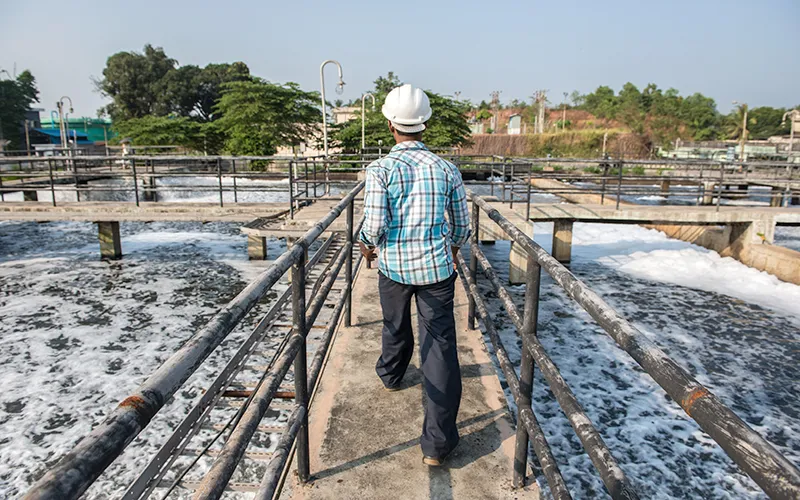Despite the worldwide call for a change in water management paradigm in favour of demand management and ecosystem restoration (also known as Integrated Water Resource Management), India still adheres to its archaic notions of water resource development. It is entirely based on the reductionist engineering paradigm looking at short-term economic benefits, and ignoring the long-term sustainability concerns. This paradigm is an integral component of the colonial legacy being introduced and formalized under colonial capitalism in South Asia leading to a 'metabolic rift' between human and nature.
The establishment of Thompson Engineering College at Roorkee (now IIT Roorkee) during the British era provided young Indian students with training in the European knowledge of water engineering. This reductionist knowledge of water management spread across engineering colleges in India over time. Early British projects had been exemplified by the Sarada Barrage, flood control of the Kosi, and the Upper Ganges Canal to divert water from the Ganges at Hardwar near Roorkee to Kanpur. This "structuralist" tradition continues even today, along with the tradition of the dominating numbers of civil engineers in the Ministry of Water Resources.
Unfortunately, the British engineers, who brought their European engineering knowledge to India, hardly had any idea of the Indian rivers. The hydrographs of most European rivers were almost horizontal lines, hardly revealing any seasonal pattern. There is definitely no concept of "drought" (or lean season flow) and "floods" (peak flow) in this paradigm of "arithmetic hydrology". When monsoon occurred in the Indian sub-continent, and submerged the Ganges or the Cauvery floodplains at its own usual wont, it was thought of as an aberration.
Therefore, most 'structuralist' interventions in the colonial and post-colonial era were conceived of from the perspective of irrigation, and to a smaller extent, hydropower. Firstly, these designs hardly took into consideration the concerns of eco-hydrology, treating floods and droughts as integral components of the eco-hydrological cycle. Secondly, hydro-meteorology, understanding the relation between meteorological variables and extreme events too are ignored. And, finally, this approach ignores seismic science and making the structures resistant to earthquakes. It almost appears as if the construction, by itself, is an end. For instance, there is hardly any information available in public domain on: whether and to what extent the Tehri dam on the Himalayan Uttarakhand is earthquake-resistant.
The government engineers were also oblivious of the role of sediment, and how to manage them effectively. Because European rivers are hardly sediment-laden like Indian rivers, engineers in the Ministry hardly created documentation of sediment in the planning and conceptualization stage; neither was there any recognition of its critical ecosystem service in the context of providing food security, nor of the menace that it can cause through accumulation in a dam thereby restricting its functioning. The Bihar floodplain in the Ganges sub-basin of India is a case in point. Apparently perceived as "flood damage", the floodwater, upon receding, leaves behind rich silt and micronutrients that have helped in the natural creation of "rice bowl" of South Asia. Further downstream, the Farakka barrage, constructed in 1975 to resuscitate the Calcutta port, has resulted in stream-flow depletion in its natural course, because of excess sedimentation. This has, in turn, affected the mangrove forests, and the associated ecosystem services for the human communities in the delta regions of Sundarbans. Quite unfortunately, the most critical concern that the government engineers miss out even today is that the livelihoods of the poor in the developing world are reliant on ecosystem services.
India's water policy documents and implementation plans conveniently ignore many such concerns, or acknowledge them with own definitions of convenience. The same is true when the policy document incorporates the notion of "environmental flows", whose globally accepted definition is "the quantity, timing, and quality of water flows required to sustain ? ecosystems and the human livelihoods ? that depend on these ecosystems". Much in contrary to this definition, National Water Policy 2012, Govt. of India, states, "? a portion of river flows should be kept aside to meet ecological needs ensuring that the low and high flow releases are proportional to the natural flow regime, including base flow contribution in the low flow season through regulated ground water use". Similarly, the ludicrously suicidal idea of interlinking of rivers is based on the unsubstantiated premise of "scarce" and "surplus" basin definition, which is again the creation of this reductionist engineering thinking. There is simply no recognition that every drop of water has an ecological function, by way of which ecosystem services are provided to the human community.
On the other hand, China has developed its own set of ecologically informed engineering while designing its dam on Yangtze. The design helps in flood control, and also uses the peak flow to use the sediments effectively for downstream floodplain cultivation. Therefore, unless social and ecological concerns are featured in the engineering designs, Indian problems will persist: we will keep on linking rivers without thinking of their egregious social-ecological impacts; recreate situations that will lead another Uttarakashi disaster; or create another Farakka barrage to destroy the downstream delta. Fluvial geomorphology of Indian Rivers, segregating the Himalayan and Deccan rivers, needs to have an integrated basin management approach, rather than a myopic engineering approach!
(The writer is a Senior Fellow at Observer Research Foundation, Kolkata, and Senior Economic Advisor at WWF-India).
Courtesy: www.abplive.in
The views expressed above belong to the author(s). ORF research and analyses now available on Telegram! Click here to access our curated content — blogs, longforms and interviews.




 PREV
PREV


